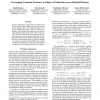Free Online Productivity Tools
i2Speak
i2Symbol
i2OCR
iTex2Img
iWeb2Print
iWeb2Shot
i2Type
iPdf2Split
iPdf2Merge
i2Bopomofo
i2Arabic
i2Style
i2Image
i2PDF
iLatex2Rtf
Sci2ools
AAAI
2015
2015
Leveraging Common Structure to Improve Prediction across Related Datasets
In many applications, training data is provided in the form of related datasets obtained from several sources, which typically affects the sample distribution. The learned classification models, which are expected to perform well on similar data coming from new sources, often suffer due to bias introduced by what we call ‘spurious’ samples – those due to source characteristics and not representative of any other part of the data. As standard outlier detection and robust classification usually fall short of determining groups of spurious samples, we propose a procedure which identifies the common structure across datasets by minimizing a multi-dataset divergence metric, increasing accuracy for new datasets. Problem statement Often, the data available for learning is collected from different sources, making it likely that the differences between these groups break typical assumptions such as the samples being independent and identically distributed. It is often the case that da...
| Added | 27 Mar 2016 |
| Updated | 27 Mar 2016 |
| Type | Journal |
| Year | 2015 |
| Where | AAAI |
| Authors | Matt Barnes, Nick Gisolfi, Madalina Fiterau, Artur Dubrawski |
Comments (0)

